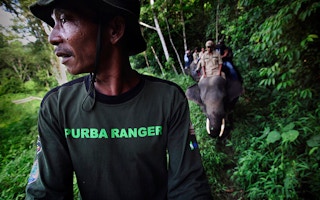Indonesia’s Leuser Ecosystem lost 4,097 hectares of forest cover in the first six months of 2016, according to Forest, Nature and Environment of Aceh (HAkA), an NGO. At the same time, 187 fire hotspots were recorded in the nationally protected area during the period.
“The hotspots overlay the forest cover loss in Aceh,” HAkA’s Agung Dwinurcahya said at a press conference in Jakarta. “For example, the high number of hotspots in Aceh Timur is the main contributor to deforestation in Aceh Timur.”
Leuser, home to one of the Southeast Asian country’s last great swaths of intact rainforest, lies in Indonesia’s westernmost Aceh and North Sumatra provinces. It’s the only place in the world where orangutans, rhinos, elephants and tigers coexist in the wild.
East Aceh district, which borders the Malacca Strait to the northeast, bore the brunt of the deforestation: 1,870 hectares, with 56 hotspots. Next on the list was mountainous Gayo Lues district: 405 hectares of forest loss, 31 hotspots. Followed by South Aceh district on Sumatra’s western coast: 378 hectares, 30 hotspots.
“
The locations inside the Leuser Ecosystem with the most fires, clearing and forest crimes correlate with the locations we find the most cases of human-orangutan conflict.
Ricko Laino Jaya, Orangutan Information Centre
Deforestation in Leuser has squeezed the region’s critically endangered Sumatran orangutan (Pongo Abelii) populations, of which only around 14,000 are thought to remain.
“The locations inside the Leuser Ecosystem with the most fires, clearing and forest crimes correlate with the locations we find the most cases of human-orangutan conflict,” said Ricko Laino Jaya, of the Orangutan Information Center (OIC).
From 2012-2016, the OIC’s Human and Orangutan Conflict Response Unit has rescued 106 orangutans from isolated forest fragments and illegal pet owners. 2015 was the year in which the most orangutans were rescued and 2016 is on pace to match it.
The Leuser Conservation Forum is an NGO that works closely with HAkA to patrol the Leuser Ecosystem. Its conservation manager, Rudi Putra, said the organisation had recorded 2,398 forest crimes in Leuser during the first half of the year, ranging from poaching, to illegal road construction and logging to forest encroachment. Around a quarter of these occurred in Aceh Tamiang district, where illegal oil palm plantations are rife.
More than 3,600 cubic meters of timber were seized in a total of 984 cases of illegal logging in Leuser during the period, according to Putra. Poaching was concentrated in South Aceh, with 122 cases reported, 121 animal traps destroyed and 42 poachers apprehended.
“Finding over 2,000 forest crimes inside the Leuser Ecosystem within six months is shocking. We have reported every crime to local authorities,” Putra said.
This story was published with permission from Mongabay.com

















